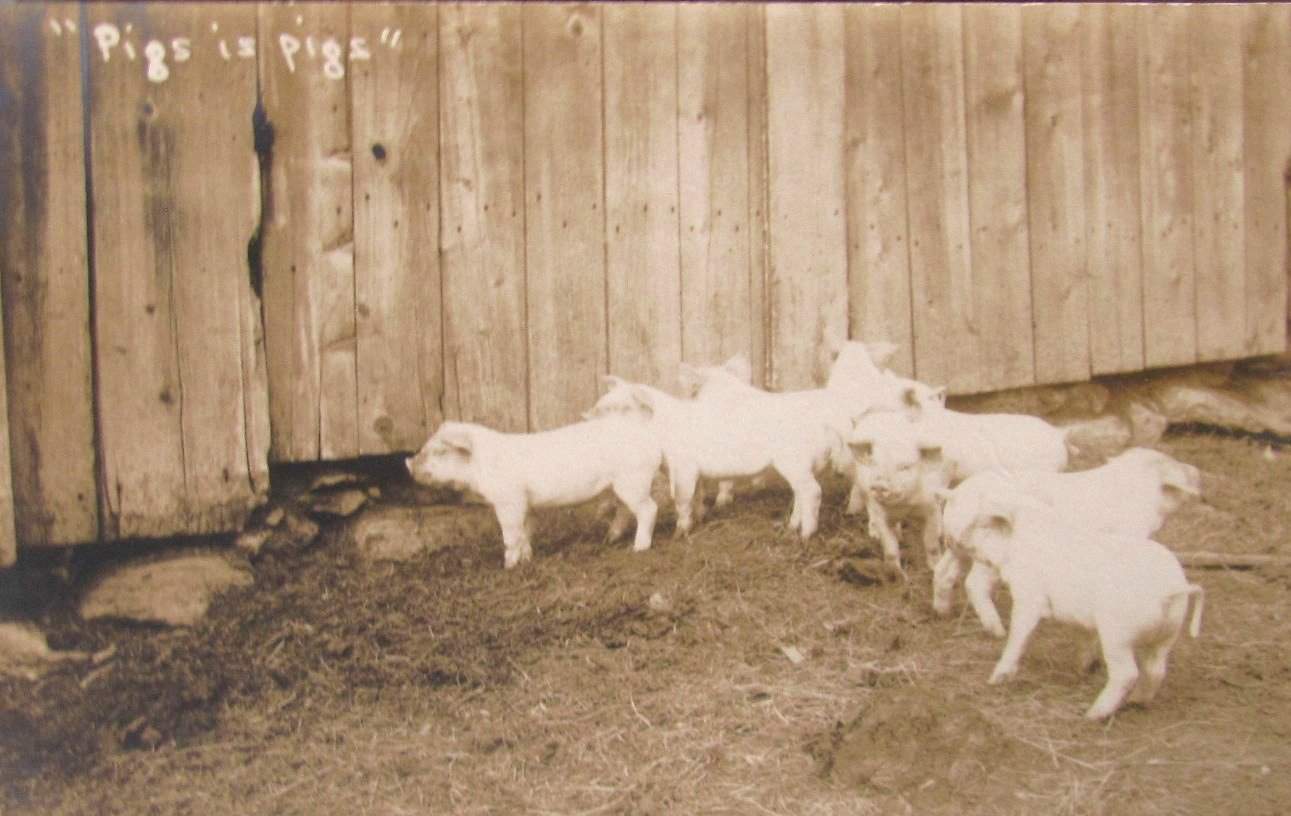
As most of you know, I collect old postcards. In Chester our postcard photographer was Charles Wellman. His studio was the small place next to the library. Obviously I look for his cards. Harry Chapman was the Windham photographer.
Wellman took more portraits than he did views around town. Chapman took hundreds and hundreds of photos of daily life in the Windham area.
Both men knew each other and probably worked together now and then. I have a photo of a young Harry Chapman that was taken by Wellman in the early 1900s.
There are dozens of categories you can collect. I like photos of men with oxen, horses, and wagons. I also collect photos of pigs. Not many photos of pigs were taken. The photo with this article was taken by Harry Chapman.
At upper left: “Pigs is pigs.” Both Wellman and Chapman used a camera that took glass plates instead of roll film. Photographers of the day sometimes wrote in white letters a title for the photo, directly on the glass plate. This way each photo developed had the title included. Such is the case with “Pigs is pigs.”
There are eight or nine young piglets pictured. Probably all are the same litter. This is one reason Chapman cards appeal to me. He left us an amazing photographic history.
This is a card that makes me smile. I bet Chapman felt the same way. This is a card few people would have bought. Chapman probably printed less than a dozen, so they are scarce today.
Another Chapman card I have is of a woodcock sitting on her nest. To capture this photo would have required a lot of patience and skill. How it was done:
Chapman could have been in the woods for many different reasons. Walking around, he flushed the woodcock. Looking around he would have seen the nest on the ground. If he didn’t have his camera with him he would have gone and got it.
Now he had to wait for the woodcock to return to her nest. He would have chosen a spot, somewhat hidden yet open, and close enough to take the photo. I would think the woodcock would have returned in a few minutes to sit on her eggs.
The woodcock’s plumage is very much a camouflage pattern and colors. This camouflage is so good that you have to look close to see the woodcock in the photo. I would like to have known Chapman.
Well there’s not much more to write about pigs, so I round out this article with the Yosemite Ghost. The author of this poem is unknown, as is the time period.
YOSEMITE FIREHOUSE GHOST
“The winter had been so nice and quiet.
The middle of May, it became a riot.
What happened to make it so, you say?
Bunch of school kids came on Thursday.
Mrs. Ghost and I have been sleeping late.
No call for any scary dates.
With kids around, our sheets got torn.
That’s why we are looking so forlorn.
All we are is a sheet, you know.
Without them there’s nothing to show.
You’ll think of us when you go to bed.
And pull the sheet over your head.
That’s how we will get even with you.
For coming to our house to make such a stew.
That will show you where we are all at.
On windy nights when fast asleep
You’ll wake up when we tickle your feet.
Do no good to scream and holler
Dad won’t believe you. Bet you a dollar
The Yosemite Ghost will fool around
Until every kid in this whole town
Gets rid of every Ghostly sheet
If they want a real good sleep.”
Instead of an old saying, I offer a short story. It was about 1975 when I stopped in Rutland to see my brother Brian and his wife Irene. Brian wasn’t home so Irene and I visited. Irene was a prolific reader. She told me about a scary book she was reading. It was about, “Tear-an-too-las.” I asked what they were. Irene told me they were large, deadly spiders. Tarantulas!